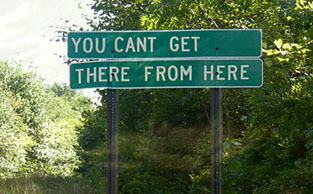
Among the many things that I will never understand about this life, one item ranks high: the peculiar incompetence some people exhibit when they are required to give directions to their place of residence.
“Go down the street out front until you get to the old red barn that burned down last year, and turn right. You can’t miss it.”
Pianos are delivered far and wide, in cities and in the country, in neighborhoods and apartment complexes, up stairs and down stairs, over creeks, up mountains and through the woods.
It was near Slippery Rock, years ago, that I braved a winter storm to deliver a console organ out in the country. The owner stood on the stoop and watched as two of us lifted the organ shoulder-high to keep it out of the knee-deep snow. The owner had given us directions to his house, but had failed to mention that we would have to carry the organ across a large lawn – one without a sidewalk.
A lady calls for a tuning from an apartment complex. Access to the complex requires a key code to open the security gate. Where is the key pad located? She didn’t say. One would assume it was near the gate. On this occasion, it wasn’t. It was near another building that I had already driven past. That would have been good information to know.
A gentleman purchased a 6′ 6″ Yamaha piano from me back in the 80s. He gave us directions to his home. He failed to mention that he lived on the third floor of an apartment building, one that had six flights of stairs. The length of the piano required the movers to remove and replace the banisters on the end of each half flight of stairs.
Regarding the barn, the one that burned down last year, that also really happened. I received directions from a lady at the gas station on a country road. I was following the directions given to me by the customer – which means I was lost. So I stopped at the gas station.
“Go down the street out front until you get to the old red barn that burned down last year, and turn right. You can’t miss it.”
“Ma’mm,” I said, “If the barn burned down last year, then I am not going to be able to see it to know to turn right.”
She smiled and said, “Well, everyone from round here knows where that barn is.”
And of course, I am not from here, which is why I cannot find the barn. I wonder how many others she has directed since the barn burned down! They may still be out there driving around.
One more – On one delivery I asked how many steps there were. The owner replied there were none. When I arrived, it was a step out of the sunken living room, a step down to the porch, and a series of small steps down the sidewalk. When I reminded her that she had told me there were no steps, she replied, “Those aren’t steps.”
Why Me?
Why are people sometimes unable to give proper directions to their homes? It might be because they never have people come over. Maybe it is because they lack any sense of direction, or maybe they have always depended on someone else to take them where they needed to go.
Some people do not know north from south. I grew up in a town that had roadways that were built on a spoke system. The map of the city looked like a large bicycle wheel. Every major road went to the center of town, or it went away from it. A North-South bearing didn’t help you much in that town. You either went toward town, or away from town.
Later in life I moved to Chicago. Everything is North-South there; built on a big grid of roads. That was an easy city to navigate. Oklahoma City is also a grid, but it is divided into quadrants. Hard to navigate but not as bad as Tulsa. Tulsa is unique because the city streets are on a North-South grid, but the highway runs through the town like one big X, making all North-South roads 45 degrees out of kilter. I’ve had trouble in the past orienting myself to a North-South bearing after exiting the highway. Local people think it is easy to get around Tulsa. I learned how to do it eventually. Some people are still trying to figure it out, I imagine.
Today I trust no one’s directions. That is the rule. Thank goodness for Google maps. It saves me lots of time. I no longer have to look for burned down red barns, or stop and ask directions at gas stations. In the metropolitan area, people who work at gas stations usually don’t live in the town where the gas station is located. They have no idea where anything is. And yet, people stop and ask for directions to get where they thought they knew how to get to.
I suspect that people who cannot give directions are also the same people who cannot follow directions. In my day, I have helped a lot of people with directions. I have found that people who cannot follow directions are also people who will not listen to directions. They also will not write down the directions you give them. They get back in their car, and they go down the road, and they miss the barn – again and again.
If you ask enough people for directions, you will eventually encounter someone who will answer, “You can’t get there from here.” I love that answer. It applies to so many people. Most people hear that statement and think that there are no roads between there and here. When I hear that answer, I think it means, “You are too lost to ever get there. Go back the way you came. Stop trying.”
There is some truth to that. Maybe the reason people get lost is because they try to find places they don’t really need to go to. Maybe we all just need to stay home and watch a movie. Even if that is good advice, pianos still have to be tuned, moved and delivered. And for that reason, when I ask for directions, I ask a lot more questions that most people ask.
“… And how many steps are there in the home?”
“Not many.”
“How many exactly? The delivery crew will need to know.”
“Well…six or seven.”
“Which is it, six or seven?”
“How am I supposed to know!?”
“You live there.”
And that is the end of this blog. I still do not understand why people cannot give directions to their homes. I will still ask questions, and I will still get lost. It is all part of life I suppose.
![Lake Dillon and a Tree [In Explore] Lake Dillon and a Tree [In Explore]](https://live.staticflickr.com/65535/53731226172_4004cbfea4_s.jpg)




















You must be logged in to post a comment.